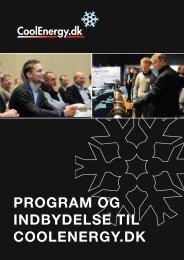Air-Source vs. Water/Ground-Source Heat Pump Systems ...
Air-Source vs. Water/Ground-Source Heat Pump Systems ...
Air-Source vs. Water/Ground-Source Heat Pump Systems ...
You also want an ePaper? Increase the reach of your titles
YUMPU automatically turns print PDFs into web optimized ePapers that Google loves.
CoolEnergy.dk – March 6-7 th, 2013 – Odense, Denmark<br />
Discharge Gas Temp. <strong>vs</strong>. Evaporation Temp., t E<br />
Discharge Trykkgasstemperatur Gas Temp. (°C) (°C)<br />
150<br />
140<br />
130<br />
120<br />
110<br />
100<br />
90<br />
80<br />
70<br />
60<br />
50<br />
-30 -25 -20 -15 -10 -5 0 5 10 15 20<br />
Evaporation Fordampningstemperatur Temperature, (°C) t E (°C)<br />
R410A<br />
R407C<br />
R134a<br />
R744 (CO2) (CO2)<br />
R717 (NH3) (NH3)<br />
R290 (propan) (propane)<br />
› Disch. gas temp. increases<br />
with decreasing t E<br />
› Increasing temperature<br />
lift (∆t) for the heat<br />
pump at decreasing t E<br />
› Decreasing compressor<br />
efficiency (η is ) at increasing<br />
pressure ratio (π)<br />
› High discharge gas<br />
temp., thermal load<br />
› Lubricant carbonization,<br />
decomposition of refrigerant<br />
and leakage risk<br />
Single-stage unit – t C =45 °C – compressor efficiencies not incl.<br />
› Increase wear and tear,<br />
compressor failure<br />
14<br />
MARCH 7TH, 2013<br />
COWI POWERPOINT PRESENTATION




